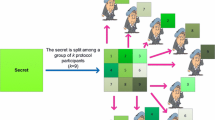Abstract
Most of the cryptographic protocols nowadays, mainly asymmetrical, have a generated user personal key as their basis, known only to them but still vulnerable to theft. There can be proposed an innovative solution, which hashes the cipher with chosen key and uses some personal characteristics of the person generating it (e.g., by voice sampling or biometrics, encoded as a bit vector). Such a private key would be usable only by its creator, making the design much safer and authenticating him personally, making the non-repudiation of encoded material possible. Also, with the proposed solution, another avenue of research has been opened by using such a technique in steganography - encoding information in the user-provided picture, secured by his biometric sequences (quality vectors). In both cases, the cryptographic protocols take on truly unique sequences, used instead of traditional salt values, also providing a layer of truly personal touch to an otherwise purely theoretical construct. It may find many applications in the growing world of IoT where people and their unique needs have to be incorporated into the growing web of security protocols.
Access this chapter
Tax calculation will be finalised at checkout
Purchases are for personal use only
Similar content being viewed by others
References
Sfar, A.R., Natalizio, E., Challal, Y., Chtourou, Z.: A roadmap for security challenges in the Internet of Things. Digit. Commun. Netw. 4(2), 118–137 (2018)
Loukil, F., Ghedira, C., Aïcha-Nabila, B., Boukadi, K., Maamar, Z.: Privacy-aware in the IoT applications: a systematic literature review. In: Panetto, H., et al. (eds.) On the Move to Meaningful Internet Systems. LNCS, vol. 10573, pp. 552–569. Springer, Heidelberg (2017). https://doi.org/10.1007/978-3-319-69462-7_35
Traore, I., Ahmed, E.A.: Continuous Authentication Using Biometrics: Data, Models, and Metrics, 1st edn. IGI Global, Hershey (2011)
Ogiela, M.R., Ogiela, L.: Cognitive cryptography techniques for intelligent information management. Int. J. Inf. Manage. 40, 21–27 (2018)
Menezes, A., Van Oorschot, P., Vanstone, S.: Handbook of Applied Cryptography. CRC, Boca Raton (1997)
Fierrez, J., Morales, A., Vera-Rodriguez, R., Camacho, D.: Multiple classifiers in biometrics. Part 2: trends and challenges. Inf. Fusion 44, 103–112 (2018). https://doi.org/10.1016/j.inffus.2017.12.005, ISSN: 1566–2535
Szlósarczyk, S., Schulte, A.: Voice encrypted recognition authentication – VERA. In: 2015 9th International Conference on Next Generation Mobile Applications, Services and Technologies, pp. 270–274 (2015). https://doi.org/10.1109/NGMAST.2015.74
Acien, A., Morales, A., Vera-Rodriguez, R., Fierrez, J., Tolosana, R.: MultiLock: mobile active authentication based on multiple biometric and behavioral patterns, pp. 53–59 (2019). https://doi.org/10.1145/3347450.3357663
Cox, I., Miller, M., Bloom, J., Fridrich, J., Kalker, T.: Digital Watermarking and Steganography. Morgan Kaufmann Publishers, Burlington (2008)
Ogiela, M.R., Koptyra, K.: False and multi-secret steganography in digital images. Soft Comput. 19(11), 3331–3339 (2015). https://doi.org/10.1007/s00500-015-1728-z
Bułat, R.: Zastosowanie metod ewolucyjnych w kryptografii – problem faktoryzacji. In: Metody analizy i oceny bezpieczeństwa oraz jakości informacji, Kraków (2012)
Acknowledgments
This work has been supported by the AGH University of Science and Technology Research Grant No 16.16.120.773. This work has been supported by the AGH Doctoral School Grant No 10.16.120.7999.
Author information
Authors and Affiliations
Corresponding author
Editor information
Editors and Affiliations
Rights and permissions
Copyright information
© 2022 The Author(s), under exclusive license to Springer Nature Switzerland AG
About this paper
Cite this paper
Bułat, R., Ogiela, M.R. (2022). Personalized Cryptographic Protocols - Obfuscation Technique Based on the Qualities of the Individual. In: Barolli, L., Chen, HC., Enokido, T. (eds) Advances in Networked-Based Information Systems. NBiS 2021. Lecture Notes in Networks and Systems, vol 313. Springer, Cham. https://doi.org/10.1007/978-3-030-84913-9_19
Download citation
DOI: https://doi.org/10.1007/978-3-030-84913-9_19
Published:
Publisher Name: Springer, Cham
Print ISBN: 978-3-030-84912-2
Online ISBN: 978-3-030-84913-9
eBook Packages: Intelligent Technologies and RoboticsIntelligent Technologies and Robotics (R0)




